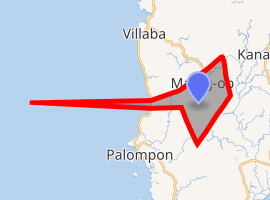Matag-ob
Matag-ob, officially the Municipality of Matag-ob, is a 4th class municipality in the province of Leyte, Philippines. According to the 2015 census, it has a population of 18,373 people.[3]
Matag-ob | |
|---|---|
| Municipality of Matag-ob | |
 Map of Leyte with Matag-ob highlighted | |

| |
.svg.png) Matag-ob Location within the Philippines | |
| Coordinates: 11°07′N 124°28′E | |
| Country | |
| Region | Eastern Visayas (Region VIII) |
| Province | Leyte |
| District | 4th district of Leyte |
| Barangays | 21 (see Barangays) |
| Government | |
| • Type | Sangguniang Bayan |
| • Mayor | Michael L. Torrevillas |
| • Vice Mayor | Bushi D. Torrevillas |
| • Congressman | Lucy Torres Gomez |
| • Municipal Council | Councilors
|
| • Electorate | 13,032 voters (2019) |
| Area | |
| • Total | 104.40 km2 (40.31 sq mi) |
| Elevation | 35.4 m (116.1 ft) |
| Population (2015 census)[3] | |
| • Total | 18,373 |
| • Density | 180/km2 (460/sq mi) |
| • Households | 4,526 |
| Economy | |
| • Income class | 4th municipal income class |
| • Poverty incidence | 35.45% (2015)[4] |
| • Revenue (₱) | 63,777,474.82 (2016) |
| Time zone | UTC+8 (PST) |
| ZIP code | 6532 |
| PSGC | |
| IDD : area code | +63 (0)53 |
| Climate type | tropical rainforest climate |
| Native languages | Cebuano Tagalog |
| Website | www |
In 1957 the barrios of Santo Rosario, Santa Rosa, Balagtas, San Vicente and Mabini were separated from the municipality of Palompon and constituted into Matag-ob.[5]
Barangays
Climate
| Climate data for Matag-ob, Leyte | |||||||||||||
|---|---|---|---|---|---|---|---|---|---|---|---|---|---|
| Month | Jan | Feb | Mar | Apr | May | Jun | Jul | Aug | Sep | Oct | Nov | Dec | Year |
| Average high °C (°F) | 26 (79) |
27 (81) |
27 (81) |
28 (82) |
28 (82) |
28 (82) |
27 (81) |
28 (82) |
27 (81) |
27 (81) |
27 (81) |
27 (81) |
27 (81) |
| Average low °C (°F) | 21 (70) |
20 (68) |
21 (70) |
22 (72) |
23 (73) |
23 (73) |
23 (73) |
23 (73) |
23 (73) |
23 (73) |
22 (72) |
21 (70) |
22 (72) |
| Average precipitation mm (inches) | 78 (3.1) |
57 (2.2) |
84 (3.3) |
79 (3.1) |
118 (4.6) |
181 (7.1) |
178 (7.0) |
169 (6.7) |
172 (6.8) |
180 (7.1) |
174 (6.9) |
128 (5.0) |
1,598 (62.9) |
| Average rainy days | 16.7 | 13.8 | 17.3 | 18.5 | 23.2 | 26.5 | 27.1 | 26.0 | 26.4 | 27.5 | 24.6 | 21.0 | 268.6 |
| Source: Meteoblue [6] | |||||||||||||
Demographics
| Population census of Matag-ob | |||||||||||||||||||||||||||||||||||||
|---|---|---|---|---|---|---|---|---|---|---|---|---|---|---|---|---|---|---|---|---|---|---|---|---|---|---|---|---|---|---|---|---|---|---|---|---|---|
|
| ||||||||||||||||||||||||||||||||||||
| Source: Philippine Statistics Authority [3][7][8][9] | |||||||||||||||||||||||||||||||||||||
In the 2015 census, the population of Matag-ob was 18,373 people,[3] with a density of 180 inhabitants per square kilometre or 470 inhabitants per square mile.
References
- "Municipality". Quezon City, Philippines: Department of the Interior and Local Government. Retrieved 31 May 2013.
- "Province: Leyte". PSGC Interactive. Quezon City, Philippines: Philippine Statistics Authority. Retrieved 12 November 2016.
- Census of Population (2015). "Region VIII (Eastern Visayas)". Total Population by Province, City, Municipality and Barangay. PSA. Retrieved 20 June 2016.
- "PSA releases the 2015 Municipal and City Level Poverty Estimates". Quezon City, Philippines. Retrieved 12 October 2019.
- "An Act Creating the Municipality of Matag-ob in the Province of Leyte". LawPH.com. Archived from the original on 2012-07-13. Retrieved 2011-04-12.
- "Matag-ob: Average Temperatures and Rainfall". Meteoblue. Retrieved 29 February 2020.
- Census of Population and Housing (2010). "Region VIII (Eastern Visayas)". Total Population by Province, City, Municipality and Barangay. NSO. Retrieved 29 June 2016.
- Censuses of Population (1903–2007). "Region VIII (Eastern Visayas)". Table 1. Population Enumerated in Various Censuses by Province/Highly Urbanized City: 1903 to 2007. NSO.
- "Province of Leyte". Municipality Population Data. Local Water Utilities Administration Research Division. Retrieved 17 December 2016.
External links
- Matag-ob Profile at PhilAtlas.com
- Philippine Standard Geographic Code
- Philippine Census Information
- Local Governance Performance Management System
This article is issued from Wikipedia. The text is licensed under Creative Commons - Attribution - Sharealike. Additional terms may apply for the media files.